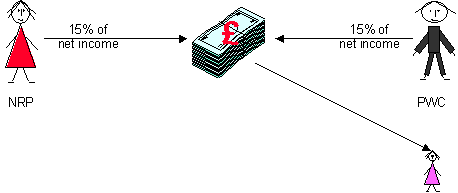Do both parents pay under the reformed scheme?
"This means that, for most parents, child support liability should be rather less than the full cost of a child." (CS Reform Green Paper)
The simplified reformed formula
The reformed formula for calculating child support liability doesn't look at the PWC's circumstances at all. It is based on just the following 4 parameters:
- NRP's net income
- number of qualifying children
- number of relevant children (those in the NRP's household)
- number of nights per week for which the NRP cares for the qualifying children
This leads many to believe that only the NRP has any responsibility to pay for the qualifying children - after all, only the NRP's income is taken into account.
(For a change, in the following diagram the NRP wears a dress and the PWC wears trousers. Perhaps they are female NRP & male PWC, or perhaps they cross-dress - take your pick).
 |
Analysis
First counter example
The above diagram is functionally identical to:
 |
But now the PWC is clearly paying towards the child - 15% of net income. The difference is just words, not reality.
The new formula (for 1 child) is equivalent to:
- mother pays 15% of her net income to the person/parent with care;
- father pays 15% of his net income to the person/parent with care.
This isn't a trick. If the person with care is not a parent, the above may be exactly what happens - both parents can be treated as NRPs and have to pay the person with care according to the same formula.
Second counter example
Suppose the formula was 1% instead of 15%, with the same cap at £2000 of net income. Then the liability could be up to £20 pw. The PWC's income is still not "overt", yet who would doubt, given researched costs of children, that in fact the PWC is necessarily paying in practice?
The PWC would probably be spending about £67 per week on the child: £20 from the NRP, about £15 from Child Benefit, and the rest ...? Well, it has to be the PWC paying, because there isn't anyone else!
Result
It is a delusion to say that because the PWC's income is not mentioned in the formula, then the PWC isn't expected to pay, or hasn't got a responsibility to pay.
The truth can't be found by studying the formula under a microscope, it has to be determined by looking at real cash flow in practice.
The argument is not whether both mother & father pay in theory - they do. The argument is whether the amount paid by the NRP is "too much", so that the money that a PWC pays to the PWC doesn't have to be spent on the child. THAT needs an understanding of liabilities versus child expenditures. If all NRP liabilities were less than child expenditures, then indeed PWCs would be spending their net income on the child.
In effect, what people are arguing for is that the mother's liability takes into account both parents' incomes, and ditto for the father's liability. Fine. That is how it was. It may be a more accurate reflection of child expenditures in the UK. Most (all?) research shows a slower increase in expenditure than is implied by a straight percentage of parents' income. But most research also shows that the expenditure is much higher than the average NRP liability, even for 1 child, and the difference is greater for 2 or more. So the new formula starts to exceed the typical expenditure in an intact family at higher than average incomes. Also, the cost of a child increases at separation.
And there is another argument that that has been seen - do NRPs want their liability to rise suddenly if the PWC drops out of work (eg. because of a new partner)?
What people are after is a symbol. In fact, the best symbol would be to formally award the CS to the child, not to the PWC. And get a symmetrical shared-care formula, of course.